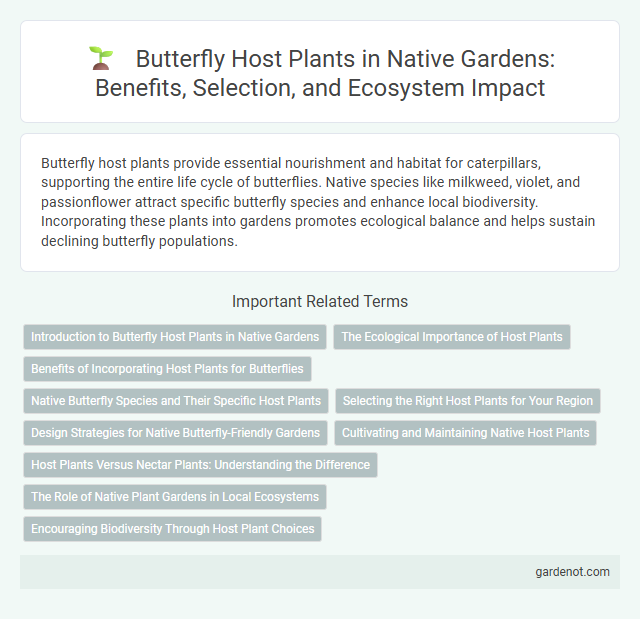Butterfly host plants provide essential nourishment and habitat for caterpillars, supporting the entire life cycle of butterflies. Native species like milkweed, violet, and passionflower attract specific butterfly species and enhance local biodiversity. Incorporating these plants into gardens promotes ecological balance and helps sustain declining butterfly populations.
Introduction to Butterfly Host Plants in Native Gardens
Butterfly host plants serve as essential habitats where butterflies lay their eggs and caterpillars find nourishment, crucial for supporting local butterfly populations in native gardens. Native species like milkweed, passionflower, and spicebush provide specific nutrients required by butterfly larvae, promoting biodiversity and ecological balance. Incorporating these plants into garden designs enhances pollination and fosters sustainable ecosystems by sustaining the full butterfly life cycle.
The Ecological Importance of Host Plants
Butterfly host plants serve as essential habitats for butterfly larvae, providing critical nourishment that supports their growth and metamorphosis. These plants maintain biodiversity by sustaining native butterfly populations, which in turn facilitate pollination of various flora. Protecting and planting native butterfly host species enhances ecosystem resilience and promotes balanced food webs.
Benefits of Incorporating Host Plants for Butterflies
Incorporating butterfly host plants into native landscapes supports local butterfly populations by providing essential sites for egg laying and larval development, which boosts species diversity and ecological balance. These plants enhance pollination processes, benefiting surrounding flora and aiding in the sustenance of native ecosystems. Providing specific host plants such as milkweed for monarchs or parsley for swallowtails creates a vital habitat, promoting butterfly survival and encouraging natural pest control through increased insect biodiversity.
Native Butterfly Species and Their Specific Host Plants
Native butterfly species rely on specific host plants for laying eggs and supporting caterpillar development, such as the Monarch butterfly using milkweed (Asclepias spp.) and the Black Swallowtail depending on parsley, dill, and fennel. Planting native host plants like goldenrod (Solidago spp.) for the Monarch or spicebush (Lindera benzoin) for the Spicebush Swallowtail enhances local butterfly populations. Conservation of these critical host plants supports biodiversity and ensures the survival of native butterfly species through all life stages.
Selecting the Right Host Plants for Your Region
Choosing native butterfly host plants specific to your region supports local butterfly species by providing essential food sources for caterpillars. Research native milkweed varieties such as Asclepias syriaca in the Northeast or Asclepias tuberosa in the Midwest to attract monarch butterflies effectively. Selecting regional native plants enhances butterfly survival rates and contributes to maintaining biodiversity within local ecosystems.
Design Strategies for Native Butterfly-Friendly Gardens
Incorporate native butterfly host plants such as milkweed, passionflower, and spicebush to attract and support local butterfly species during their life cycles. Cluster these plants in sunny, sheltered areas to create microhabitats that provide food, shelter, and breeding sites, enhancing butterfly survival rates. Design gardens with layered plant structures offering nectar sources nearby to cater to both caterpillars and adult butterflies, promoting biodiversity and ecological balance.
Cultivating and Maintaining Native Host Plants
Cultivating native butterfly host plants requires selecting species adapted to local climate and soil conditions, such as milkweed for monarchs and spicebush for swallowtails. Maintaining these plants involves regular monitoring for pests, providing adequate water during dry periods, and avoiding chemical pesticides to protect caterpillars and eggs. Encouraging native plant diversity supports healthy butterfly populations by offering essential food and shelter throughout their life cycles.
Host Plants Versus Nectar Plants: Understanding the Difference
Butterfly host plants serve as essential breeding sites where butterflies lay their eggs and caterpillars feed exclusively on these plants, ensuring proper larval development. Nectar plants provide adult butterflies with vital energy sources through nectar but do not support caterpillar growth. Distinguishing between host and nectar plants is crucial for native planting strategies aimed at supporting the complete butterfly life cycle and promoting biodiversity.
The Role of Native Plant Gardens in Local Ecosystems
Native plant gardens serve as critical habitats for butterfly host plants, supporting the complete lifecycle of butterflies by providing essential resources for egg-laying and caterpillar nourishment. These gardens enhance local biodiversity, promoting ecological balance by sustaining pollinators and other native wildlife. Incorporating native butterfly host plants strengthens ecosystem resilience and fosters a sustainable environment for future generations.
Encouraging Biodiversity Through Host Plant Choices
Butterfly host plants like milkweed, passionflower, and violets play a crucial role in sustaining pollinator populations by providing essential food sources for caterpillars. Selecting native species as butterfly host plants encourages local biodiversity by supporting the entire lifecycle of butterflies and other beneficial insects. Incorporating diverse native host plants in gardens enhances ecosystem resilience and promotes balanced habitats for wildlife.
Butterfly host plant Infographic

 gardenot.com
gardenot.com